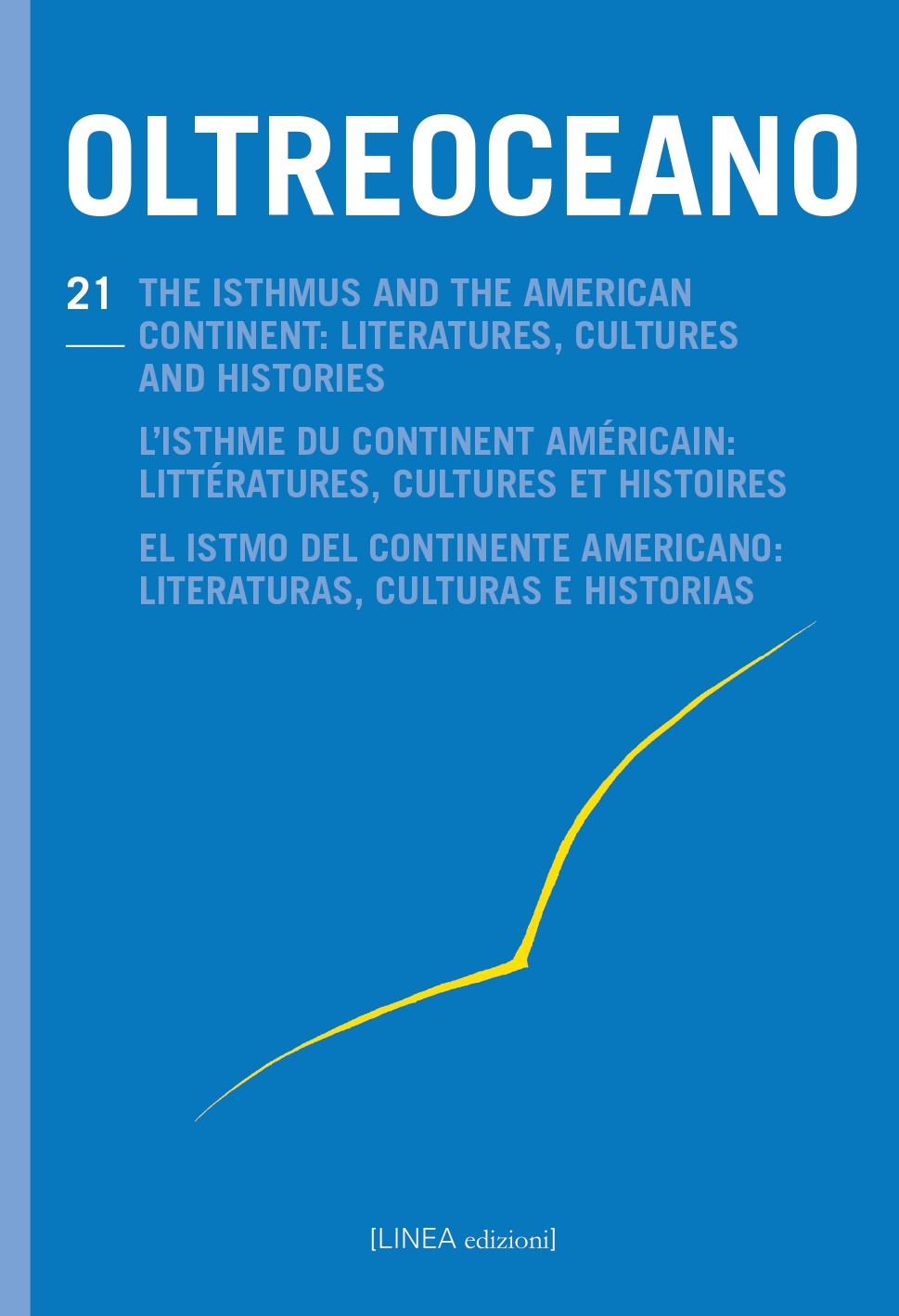The Histmic Territory between Heterogenous Literary-Experiences
DOI:
https://doi.org/10.53154/Oltreoceano75Keywords:
literature, culture, istmic space, globalization, frontierAbstract
The aim of the following study is to discuss the concept of bridge of contact as the one conceived among the Anglophone, Francophone, Latin American realities. In particular it will enquire the mode in which it is exercised in the entire histimic zone ‒ and by extension in all central American states, including the islands, located between North America and South America. In the aesthetic acquisition of nature in open dialogue with the individual and with society, literature becomes a focal point for the understanding of the outer world and the inner microcosm, while at the same time it indicates the voyage within the physical space as a mere necessity for all those who intend the act of writing as a mission towards knowledge. The contact between cultures af fects all identity issues and establishes new points of reference, transforming culture into richness and even individual awareness. For this reason, stemming from the very context, it is interesting to verify whether in literary texts, be they in English, French or Spanish, the impetus towards a relentless globalization is affirmed or whether the choice to cultivate one’s own cultural roots, albeit modified or “contaminated”, prevails within a multicultural territory. It is no coincidence that literature treads the paths of tradition, opening up to experimentation, the discovery of linguistic relationships, new fields of expression and to a mixture of genres. On the one hand, poetry, novels, drama and essays draw onto a real symbolic of bewilderment, while on the other hand the fantastic element develops into an attempt to recover or evade the breaking of the order of the polis, transformed into an uncoordinated, fragmented and incompressible space. From a methodological point of view, exegesis is based on the process of transculturation Fernando Ortiz alludes to, reinforced by Ángel Rama, Derek Walcott and Édouard Glissant who extends the concept to one of globalization. And again it is based on the hybridization of cultural interrelations that change in the evolution of historical-social processes, and reflects glimpses of multiple cultures that put into play any fixed concept of a defined identity and of the construction of a national identity, as studied by Néstor García Canclini.
Downloads
References
Aguilera-Malta, D. Z. (1935): Canal Zone. Los yanquis en Panamá. Santiago de Chile: Ercilla.
Aguilera Rivera, J. A. (2004): El sonido y la furia. La persusión multicultural en México y Estados Unidos. México: Taurus.
Bolívar, S. (1976): Discurso pronunciado por el Libertador ante el Congreso de Angostura el 15 de febrero de 1819, día de su instalación. En A. Baeza Flores (Ed.), Simón Bolívar. San José de Costa Rica: Ministerio de Cultura, Juventud y Deportes, Depto. de Publicaciones.
Carini, S.; Ortiz Wallner, A. & Pleitez Vela, T. (2019): Centroamérica en movimiento. Introducción. Centroamericana , 29, 1, pp. 9-14.
Demyk, N. (1995): Los territorios del Estado-Nación en América Central: una problematica regional. En A. Taracena & J. Piel (Eds.), Identidades nacionales y estado moderno en Centroamérica (pp. 13-30). México: Centro de Estudios Mexicanos y Centroamericans. Recuperado de http://books.openedition.org/cemca/3211 (Visitado el 21/02/2022).
Fajardo Fajardo, C. (2020, enero-junio): La poesía en tiempos de exclusión. Introducción. Cuadernos de Literatura del Caribe e Hispanoamérica, 31, pp. 15-26. Recuperado de http://investigaciones.uniatlantico.edu.co/revistas/index.php/cuadernos_literatura/article/view/2534 (Visitado el 12/02/2022).
García Canclini, N. (1990): Culturas híbridas, estrategias para entrar y salir de la modernidad. México: Grijalbo.
Gardini, G. L. (2009): L’America Latina nel XXI secolo. Nazioni, regionalismo, globalizzazione. Roma: Carocci.
Glissant, É. (1998): Poetica del diverso, 1996. Roma: Meltemi.
Glusberg, J. (1978): Retórica del arte latinoamericano. Buenos Ares: Nueba visión.
Jossa, E. (2019): Espacios fluidos / detenidos. Movimiento y detención en cuatro cuentos centroamericanos. Centroamericana, 29, 1, pp. 127-147.
Liano, D. (1997): Visión critica de la literatura guatemalteca. Guatemala: Universitaria, Universidad de San Carlos de Guatemala.
López Ruíz, F. (2008): McWorld no se escribe con ñ: El problema es México. Studi Latinoamericani / Estudios Latinoamericanos, 04. Special Issue M. Sartor & S. Serafin (Eds.), Globalità e localismo, pp. 55-83.
Ortiz, F. (2002): Contrapunteo cubano del tabaco y el azúcar, 1940. Madrid: Cátedra.
Pizarro, A. (Ed.) (1985): La literatura hispanoamericana como proceso. Buenos Aires: Centro Editor de América Latina.
Pizarro, A. (1994): Palabra, literatura y cultura, I-III. Sao Paulo: Fundaçao Memorial de America Latina.
Rama, A. (1989): Transculturación narrativa en América Latina. México: Siglo XXI.
Scarabelli, L. (2008): Identità e rappresentazione. Dire l’America Latina nei nuovi scenari postglobali. Studi Latinoamericani / Estudios Latinoamericanos, 04. Special Issue M. Sartor & S. Serafin (Eds.), Globalità e localismo, pp. 369-385.
Walcott, D. (1992): Mappa del Mondo Nuovo (Collected Poems, 1948-1984; 1986). B. Bianchi, G. Forti & R. Mussapi (Traduzione). Milano: Adelphi.
Downloads
Published
How to Cite
Issue
Section
License

This work is licensed under a Creative Commons Attribution-NonCommercial-ShareAlike 4.0 International License.
The authors undertake to comply with the following conditions, which are considered accepted at the time of submission of their contributions.
The sending of a text implies that it is unpublished and not submitted to be published elsewhere.
1. If accepted, the author shall confer on the publisher the right to publish and distribute it both in paper form and in the online electronic edition. The published articles will be downloadable and made available in open access.
2. Provided that it correctly indicates that the first publication took place in the journal Oltreoceano. Rivista sulle migrazioni the author has the right to: a) reproduce the article in separate extracts or collected in a volume; b) publish the article on their personal website or teaching site provided that these sites are of a non-commercial nature; c) deposit the article in online archives of a non-commercial nature, linked to the institution they belong to or as part of projects for the non-commercial dissemination and open access of scientific works.
The use of contributions by third parties, for commercial or otherwise unauthorized purposes, is not allowed. The publisher declines all responsibility for the unauthorized use of the material published in the journal.












